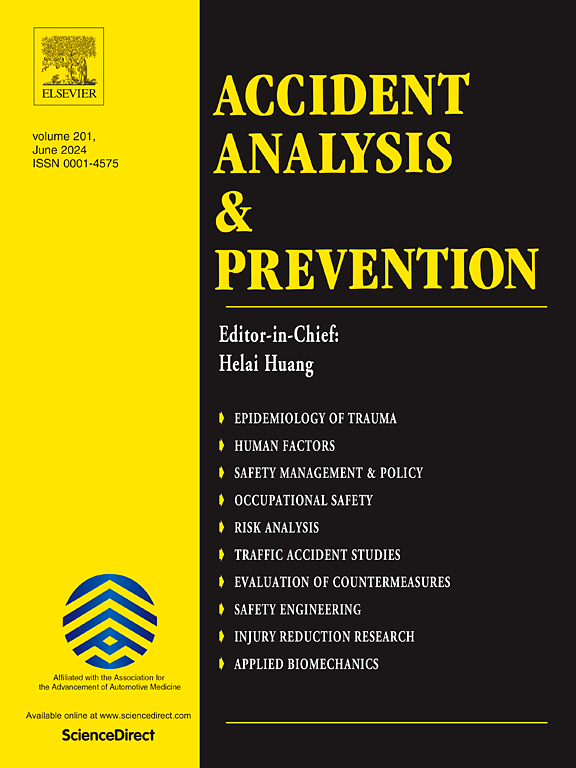An analysis of bus drivers’ interactions with motorists
IF 5.7
1区 工程技术
Q1 ERGONOMICS
引用次数: 0
Abstract
Driving a bus in the city is a task that demands attention to changing road conditions while dealing with passengers’ needs. Bus drivers often experience aggression from passengers and other road users, which sometimes escalate, eventually leading to violence. However, many road conflicts are rarely reported and, hence, difficult to study. This article analyses bus drivers’ reactions to conflicts with other motorists in Santiago (Chile), where public transport accounts for 35% of the total trips. Four percent of the population of bus drivers (639) responded to a survey with questions about job satisfaction, the bus route, and experiences of conflicts and accidents with other vehicles. A Mixed Logit model was estimated to explore bus drivers’ reactions to a conflict with motorised vehicles. The results show that bus driver’s most frequent reaction is ignoring and carrying on. If a conflict escalates, bus drivers display aggressive reactions such as violently blowing the horn, insult louder, chucking the bus onto the other vehicle, overtake the vehicle off, or start a fist fight. Being a bus driver with no previous experience of violence with other public transport buses decreases the likelihood of violent reactions, while the opposite occurs with young drivers. Interestingly, the chances of having violent response increase when the driver was female. Public policies should start paying attention to the series of minor conflicts endured by bus drivers in their routines. These conflicts often are not reported to the authorities but nonetheless, exacerbate the chronic stress that bus drivers experience.
公交车司机与驾车者的互动分析
在城市中驾驶公交车是一项任务,需要关注不断变化的路况,同时还要满足乘客的需求。公交车司机经常受到乘客和其他道路使用者的攻击,这种攻击有时会升级,最终导致暴力。然而,许多道路冲突很少被报道,因此很难研究。这篇文章分析了圣地亚哥(智利)公交司机对与其他司机冲突的反应,在那里公共交通占总行程的35%。4%的公交车司机(639人)回答了工作满意度、公交车路线、与其他车辆发生冲突和事故的经历等问题。一个混合Logit模型被用来研究公交车司机在与机动车发生冲突时的反应。结果表明,公交司机最常见的反应是忽视和继续。如果冲突升级,公交车司机会表现出侵略性的反应,比如猛烈地按喇叭、大声侮辱、把公交车扔到另一辆车上、超车、或者开始拳打脚踢。作为一名没有与其他公共交通公交车发生暴力事件经验的公交车司机,暴力反应的可能性会降低,而年轻司机的情况恰恰相反。有趣的是,当司机是女性时,发生暴力反应的几率会增加。公共政策应该开始关注公交司机在日常生活中遭遇的一系列小冲突。这些冲突通常不会向当局报告,但却加剧了公共汽车司机所经历的长期压力。
本文章由计算机程序翻译,如有差异,请以英文原文为准。
求助全文
约1分钟内获得全文
求助全文
来源期刊

Accident; analysis and prevention
Multiple-
CiteScore
11.90
自引率
16.90%
发文量
264
审稿时长
48 days
期刊介绍:
Accident Analysis & Prevention provides wide coverage of the general areas relating to accidental injury and damage, including the pre-injury and immediate post-injury phases. Published papers deal with medical, legal, economic, educational, behavioral, theoretical or empirical aspects of transportation accidents, as well as with accidents at other sites. Selected topics within the scope of the Journal may include: studies of human, environmental and vehicular factors influencing the occurrence, type and severity of accidents and injury; the design, implementation and evaluation of countermeasures; biomechanics of impact and human tolerance limits to injury; modelling and statistical analysis of accident data; policy, planning and decision-making in safety.
 求助内容:
求助内容: 应助结果提醒方式:
应助结果提醒方式:


